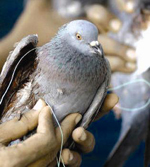
In response to petitions by animal activists, in July 2017 the National Green Tribunal (NGT) imposed a nationwide ban on nylon, cotton coated with glass and Chinese manjha used for flying kites. All states have been directed to prohibit its "manufacture, sale, storage, purchase and use". For decades Beauty Without Cruelty had been campaigning against the use of manjha which frequently resulted in grave injuries and even death to birds – animals and humans too.
This page has been kept as it was prior to the ban being declared.
Beauty Without Cruelty has drawn the attention of the Ministry of Environment & Forests that The Jain Charity Bird Hospital in Delhi treats thousands of birds like pigeons, kites and wild specie of birds, injured by sharp, glass-coated kite-string called manja throughout the year.
The manja which is usually made of cotton (the nylon ones called Chinese manja are deadlier) but an abrasive coat of crushed glass is gummed on to it making it razor sharp – each person tries to make his line the sharpest. Using this manja, kites are flown from rooftops with the aim of cutting other kite-strings, either by letting the line loose at high speed or by repeatedly yanking it.
On being cut, rival kites are seen drifting away with the wind… but innocent birds like kites and pigeons smoothly gliding in the sky are also seen falling limp to the ground. In fact, there are reports of pedestrians and people commuting on two wheelers also being injured and some killed with this deadly manja of the ‘cut’ kites slashing their necks and causing loss of blood. And then, there are the children who in their enthusiasm to catch the ‘cut’ kites also hurt themselves. If manja hits an electrical pole it can easily transmit electricity because the kite-string would have positively gathered moisture and be damp, more likely wet, and worse if it contains metal.
The Chinese manja may have originally come from China, but it is said to be made in India. Bad enough that it is used, but worse when abandoned in branches of trees either when cut, kite damaged, or when the kite-flying for the day is over. Birds do not notice it and in an effort to escape from its clutches, flap their wings in panic and the manja cuts them deeper all the while getting further entangled in their feet and bodies resulting in painful amputation and finally they bleed to death. This manja is very difficult to handle or cut, so the least that could be done by users is to gather it together and burn it, certainly not throw it away in the garbage because it can easily hurt birds and other animals that forage on garbage heaps.
The fact is that however carefully a kite is flown the manja can unwittingly severely wound birds that are flying in the air. They some how get entangled with it, struggle in panic and fall to the ground. It cuts their wings, bodies or feet so deep, it results in profuse bleeding and often gruesome death if beheaded. The Fire Brigade in Mumbai says that the maximum calls they get are to rescue birds which have got entangled in manja.
Flying kites need not be totally banned as was done in Pakistan (because of lethal kite-fights which led to many injuries and deaths due to the use of manja) but the use of manja for flying kites any where in India can be banned.
Action and Awareness
In view of the above, BWC has requested the Union Ministry of Environment & Forests to consider issuing an immediate Notification banning all types of manja. By placing this restriction on the manufacture, sale, purchase, use and possession of manja, an unimaginably high number of birds’ lives will be saved.
As manja used for kite flying cuts and profusely bleeds birds as well as humans, many NGOs have taken up the issue as a result of which year-on-year lesser injuries and deaths are reported.
Beauty Without Cruelty appeals to people not to use manja, and not to fly kites in crowded areas or near bird colonies.
For detailed information on Birds and Kite Flying please read
http://www.bwcindia.org/Web/Awareness/LearnAbout/BirdsandKiteFlying.html
|